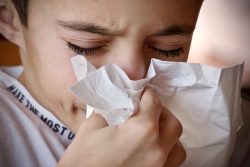Survival for any animal or plant throughout the world is a lifelong battle between the environment and the constitutional design of the organism. Health is defined in Webster as “physical and mental well-being; soundness; freedom from defect, pain, or disease; normality of mental and physical functions”. But it might well be seen as the ability to adapt to whatever the environment throws at us. Disease is defined as “any departure from health”. If then, life can be broken down into attack and defense, the first thing to consider is the nature of an attack.
Stress or Attack on the Body
The word stress has many meanings and can be used in different ways. I have chosen the definition in the Oxford Dictionary, “pressure or tension or compulsion; times of stress when much energy is needed”. Using the word this way means that our defenses are being tested by the nature of the stress. This can be mental or physical. The stresses that acted on our ancestors were much more physical. Civilization protects us from most of the physical forces that they experienced. The majority of the stress we face today taxes our mental ability and is often long-term. Physical stress is imposed by trauma or the attack of organisms, most of which we cannot see without a microscope.
The Body’s Natural Defenses
For the purposes of this discussion, think of the human body as being made up from between 70 and 100 trillion micro-organisms we refer to as cells. Each group of cells has evolved with a specialized duty, congregated together to form organs. As an analogy, the body must imitate a well-functioning orchestra. Each instrumentalist within a group of instruments is a competent musician who has to conform to the musical script dictated by the conductor. Think of body organs as being like banks of orchestral instrumentalists all playing their parts in the “symphony of health”. The “conductor” is in the brain. An infection is recognized as an attack by a microorganism and the brain initiates a defensive program. The patient feels ill, driving him or her to take rest. Body temperature is increased because the microorganism is less efficient in the presence of a higher temperature. Lymph glands may be increased in size to capture the organisms and white cells are released into the circulation to go to war with them. We refer to this as an illness, whereas we should appreciate the fact that this is organized in our defense, under the command of the brain. Many people will remember that trying to bring the temperature down with aspirin in children with a virus infection brought on a lethal condition known as Reye’s syndrome.
What Impedes the Body’s Defenses?
Genetic Variation
Each of us comes into the world with a “blueprint” or genome derived from our parents. If the DNA that forms this blueprint is perfect, we are gifted with machinery that operates the first line of defense. We know, however, that perfection is impossible and we can expect imperfections that come under the heading of genetic risk. Or the genetic mistake might be so severe that it alone will cause disease. The vast majority of genetic mistakes (changes in DNA) constitute risk rather than being absolute as the sole cause of a given disease. Some form of stress activates the brain that puts out a call for mental and physical action. As the action is consummated, the whole organism goes into defensive mode and the genetically determined fault produces its own effects. As an analogy, imagine the performance of an eight cylinder car if one cylinder becomes dysfunctional. The effect would become more obvious when more energy is required from the engine. For example, type I diabetes, generally considered to be genetically determined, actually occurs as a result of genetic risk. The very first symptoms of the disease may not appear until middle age, often precipitated by a stress factor such as a viral infection, trauma or even bad news. Huntington’s disease is caused by a genetic defect, but the symptoms are usually delayed until later life. If the gene were the sole cause of the disease, we would expect it to operate at birth. It could be the effects of aging itself or some form of life stress that “jump-starts” it. We are looking at a state of balance between attack and defense. The probable reason is that aging is an example of a gradual decline in the efficiency of energy production, thus all the components of the defensive reaction are weakened. The weakest link is more likely to be exposed
Mitochondrial Genetics
Each cell produces energy, required for its internal function. Energy is defined by Webster as “internal or inherent power; capacity for vigorous action”. This is so fundamental to life that its lack of consideration in modern medicine until recently has been truly amazing. Mitochondria are literally the “engines” of each cell, where food is converted into energy. They have their own genes in addition to the cellular genes inherited from both parents. The mitochondrial genes from the mother are the only ones to pass to both her male and female children, constituting a form of maternal inheritance. Paternal mitochondrial genes are lost at the time of conception. The energy requirements vary from cell to cell and those that are most demanding are in the brain and heart. Mitochondrial genes govern the machinery that carries out this energy synthesis, so a mistake in their DNA will cause disease in the affected individual, mainly because of lack of cellular energy. We now know that many different diseases, particularly those affecting the brain and nervous system, have a mitochondrial defect as the underlying, genetically determined risk factor. Some form of environmental stress such as a viral infection, mild trauma or even an inoculation can trigger the first symptoms of the disease. The question remains as to whether such a disease always has inherited risk, activated by stress, or whether environmental factors alone can damage the mitochondrial DNA. Energy demand must keep up with energy consumption. The sensation known as fatigue is felt in the brain and constitutes a warning that energy synthesis requires a rest. The non-caloric nutrient components (vitamins and minerals) go to work in the process of reconstitution.
Nutritional and Oxygen Deficits
Many people take for granted that we breathe but are often ignorant of the reason. The fact is that mechanisms in the lung extract oxygen from the air and place the oxygen in the blood stream. Red blood cells, coated with hemoglobin, transport the oxygen to the tissues, where it is unloaded into the mitochondria, the oxygen combines with glucose in the presence of nutrients to produce energy. This process is known as oxidation and is exactly the same in principle as burning gasoline in the cylinder of a car. The importance of thiamine is that it is the major nutrient, without which oxidation cannot take place and may be seen as the equivalent of a spark plug in a car engine. Since the greatest consumption of energy occurs in the brain, nervous system and heart, it is these organs that are the first to suffer from lack of any one of the three components necessary for oxidation. Obviously, a complete lack of glucose, oxygen, or thiamine would be lethal.
Glucose
All simple sugars are broken down in the body to glucose that is then used as the fuel. It has given rise to a common fallacy that taking sugar in any of its unnatural forms will provide “quick energy”. The manufacture of glucose in the body from food is very complex and does not rely on sugar in the many artificial ways it is consumed today. The only source should be fresh fruit, vegetables, nuts and seeds.
Oxygen
Everyone recognizes the necessity of oxygen. However, physicians often use oxygen administration in sick people without thinking about the nutrients required for its consumption. Is the suffering patient short of essential vitamins?
Non-Caloric Nutrients
There are well over 40 nutrients that are required from our food other than calories. Because there is such a huge consumption of empty carbohydrate calories, particularly in Western civilization, oxidation is compromised in much the same way as an excess of gasoline in the cylinder of a car would compromise oxygen consumption. Imperfect combustion would give rise to excessive smoke from the exhaust pipe, representing unburned hydrocarbons. The symptoms would be poor performance in the car. The symptoms experienced by someone in a state of high calorie malnutrition would be caused by poor performance in the brain. The lower part of the human brain is peculiarly sensitive to thiamine deficiency and “poor performance” could be represented as an exaggerated emotional reaction, since our emotions are the result of action in this part of the brain. An emotional reaction may give rise to depression, violent or nonviolent anger or any other emotion of which we are capable, and may be elicited with a stimulus that might otherwise be suppressed if the state of the brain was biochemically normal.
Ineffective oxidation, first perceived in the brain, might give rise to a sense of anxiety (or panic) fast beating of the heart and sweating. All of these symptoms are those of a reflex known as fight-or-flight. This is a guardian reflex, activated to prepare us for physical and mental action when confronted by danger. If such a phenomenon is experienced without an obvious external stimulus, it may result in a visit to a physician. The most likely diagnosis would normally be “a panic attack”, since the physician is not encouraged in the modern practice of medicine to consider ineffective oxidation as the basic cause. In most cases, a prescription for some form of tranquilizer would be provided, because the sense of anxiety would be regarded as the “psychosomatic” cause. This perception by the cells in the brain would constitute a dangerous state and activate the fight-or-flight reflex. The brain in this case is activating a survival reflex but does not tell the sufferer which of the missing components is responsible for ineffective oxidation. That has to be interpreted. Many forms of so-called psychosomatic disease are really examples of this. It is only the interpretation of the symptoms that enables us to perceive the reality of the situation and should not be pure guesswork.
Reconsidering Disease
An attacking agent might be traumatic injury, a microorganism (a virus or bacterium), a poison, or an environmental weather change. Each one demands a defensive response. That means that the adaptive machinery is activated: (a change from ease to dis-ease). For example, a Streptococcus attacks the throat. The defensive response is inflammation, fever, swollen glands, feeling ill (demands rest), and an overall increase in circulating white cells to attack and kill the microorganisms. All are designed to defeat the enemy, so to use a drug like aspirin to bring the fever down assists the attack. Another example is the response to environmental temperature change. If we are exposed to cold, we shiver and if we are exposed to heat we sweat. Shivering is an automatic compensatory process in the muscles that generate heat while sweating is a method of losing heat as the moisture evaporates from the skin to produce cooling. If the defensive machinery is in perfect order, the Streptococcus doesn’t even bother to attack or it is quietly subdued by the defensive machinery without a fuss. We call that good immunity. As in any form of attack, the defense has to be coordinated and that is done by the lower part of the brain. Because that is the most oxygen requiring tissue in the body, its requirement for nutritional elements, particularly thiamine, is extremely demanding. Health therefore can be defined as sufficient cellular energy to meet the demands of a hostile environment.
This puts a very different face on an “illness” (loss of ease) because the outcome depends on the virulence of the attack versus the strength of the defense. They can only be one of three outcomes: defensive victory meaning a return to wellness (ease), death from defeat by the enemy, or stalemate that might be seen as chronic disease. Ensuring that nutritional elements are present throughout life, providing the body with the ingredients it cannot make is by far and away the best prevention. If, however, an “attack” results in an “illness”, killing the “enemy” should be exercised only if it is not dangerous to the machinery of defense. The most important treatment is to provide an excess of the noncaloric nutrients to make sure that the energy supply is adequate to meet demand. This is particularly important in the treatment of chronic disease that I have represented as “stalemate”.
We Need Your Help
More people than ever are reading Hormones Matter, a testament to the need for independent voices in health and medicine. We are not funded and accept limited advertising. Unlike many health sites, we don’t force you to purchase a subscription. We believe health information should be open to all. If you read Hormones Matter, like it, please help support it. Contribute now.
Yes, I would like to support Hormones Matter.
Photo by julien Tromeur on Unsplash.
This article was published originally on August 17, 2016.
Dr. Derrick Lonsdale passed away on May 2, 2024. He will be missed.
















Dear Dr. Lonsdale,
I stumbled upon your site in my quest to improve my health. I have found the information here to be well-conveyed and thought-provoking. Thank you for sharing all of this knowledge. The question that I have is, despite the theory of Mitochondrial Dysfunction underlying most or all disease being elegant and possessing the type of explanatory power one would hope for in any unifying theory, is there any evidence in the form of randomized and controlled studies which at least strongly support if not prove Mitochondrial Function/Optimization as the main factor in healing or preventing disease?
While my background is admittedly not in the medical field, a portion of what I do financially is tied to scrutinizing evidence, and as you, I’m sure know, it is more difficult to prove something than many would imagine
I realize the limits of using only controlled/randomized studies as evidence and I also realize the value of evidence gathered in other ways. However, in my attempt to get to the root of my health issues, I’ve found that without such evidence, one is left to trial and error. (A a good friend of mine who is an accomplished Nephrologist but sadly super skeptical of anything alternative or complimentary once said to me regarding herbs (Paraphrasing to the best of my memory ” It makes sense that certain herbs have curative powers – some medicines are based on herbs but many that are traditionally reputed to help Condition X, often after some favorable small trials fail on the condition when tested more comprehensively or even when chemically modified to be used and capitalized on in the form of a drug, also ultimately fail to help. So certainly when something is untested – there is just no way to know. Lots of herbs may work for lots of things, but who knows which and for what.?” )
So many of the attempts to either introduce a panacea or theory to address a specific condition or disease and all attempts I’ve seen (thus far) to reduce all disease to a single cause fail to be proven. Many were theoretically compelling (to me at least) and almost all of them drew on case studies and much anecdotal evidence.
While the Mitochondrial /energy theory is logical and impressive, is there any reliable quantifiable evidence that it is correct?
Best Regards,
Nathan
Dr. Lonsdale passed away in May. https://hormonesmatter.com/in-memoriam-dr-derrick-lonsdale/
As far as quantifiable evidence, we wrote an entire book on the concept, citing over 800 articles. Since publication, there have been many more. Realistically though, why would one need to prove that one needs ATP/energy to live and function? Without ATP, cells die, without ATP for long enough, tissues/organs die. Eventually, we die. It absolutely fundamental to life. In fact, we cannot even use oxygen without sufficient ATP. Think hypoxia, not a hypoxia brought on by constriction or blockage, but a molecular hypoxia where their is not sufficient energy for cells to respire – for us to utilize available oxygen. ATP is life.